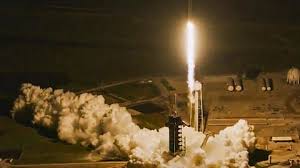Axiom-4 Mission with India’s Shubhanshu Shukla, 3 others lifts off from Florida

Cape Canaveral, Florida – June 25, 2025
India has rejoined the league of nations sending humans to space. Group Captain Shubhanshu Shukla launched to the International Space Station (ISS) aboard the Axiom-4 mission. This is India’s first crewed spaceflight since Rakesh Sharma’s 1984 mission.
The launch took place at 2:31 AM EDT (12:01 PM IST) from NASA’s Kennedy Space Center in Florida. A SpaceX Falcon 9 rocket carried the Crew Dragon capsule “Grace” into orbit.
👨🚀 Meet the Axiom-4 Crew
The Axiom-4 team represents four nations and a shared commitment to space science:
- Shubhanshu Shukla (India): A Group Captain in the Indian Air Force and the second Indian in space.
- Peggy Whitson (USA): Former NASA astronaut and mission commander with record-breaking experience.
- Sławosz Uznański (Poland): Polish astronaut representing the European Space Agency.
- Tibor Kapu (Hungary): Scientist and space researcher marking Hungary’s return to human spaceflight.
Each astronaut brings unique skills and national pride to this global venture.
🚀 A Powerful Launch
The Falcon 9 rocket lifted off flawlessly. Cheers broke out at the space center. Within minutes, the rocket placed “Grace” into orbit. The capsule now travels at 7.5 km/s, circling Earth every 90 minutes.
Shukla sent a message to India moments after launch:
“Namaskar, my dear countrymen. After 41 years, we are back in space. What a ride. Jai Hind.”
This emotional message captured the moment’s significance for India.
🇮🇳 Why This Mission Matters for India
This mission makes Shukla the first Indian to visit the ISS. It also ends a 41-year gap since India last sent a human to space.
India is preparing for its own crewed mission, Gaganyaan, expected by 2027. But Axiom-4 allows India to gain early experience through international collaboration. It’s a chance to train astronauts and collect valuable spaceflight data.
India’s participation strengthens its role in the global space economy. It also inspires future scientists and engineers back home.
🔬 Mission Objectives
The Axiom-4 crew will spend about 14 days on the ISS. Their mission includes:
- Performing over 60 experiments from 30+ countries.
- Studying microgravity effects on health, fluids, and materials.
- Hosting live educational sessions with students worldwide.
- Promoting cultural exchange through symbolic gestures and art.
These tasks will support science, education, and global unity.
🌍 A Boost for Global Cooperation
This is Axiom Space’s fourth private mission to the ISS. The company plans to build the first commercial space station by the end of the decade.
Axiom’s model encourages countries without crewed programs to join space exploration. That includes India, Hungary, and Poland. By training astronauts and offering launch access, Axiom helps spread the benefits of orbital science.
This mission proves that space is becoming more inclusive.
🔁 What Happens Next?
The Crew Dragon capsule is expected to dock with the ISS on June 26. The astronauts will be greeted by the Expedition 71 team already aboard.
After completing their mission, the crew will return to Earth. Splashdown is planned for early July, depending on weather conditions.
The capsule will land in the Atlantic or Pacific Ocean, where recovery teams will be ready.
🌟 Final Thoughts
The Axiom-4 mission marks a historic return for India to human spaceflight. Shubhanshu Shukla carries forward Rakesh Sharma’s legacy and signals a bright future for Indian space science.
This mission also highlights the new age of commercial space partnerships. Space exploration is no longer limited to a few powerful nations. It is now a shared journey across borders.
India’s return to space reminds us that the sky is no longer the limit.






